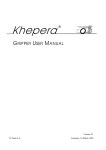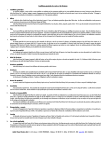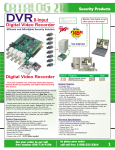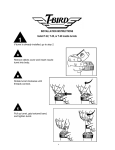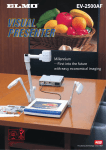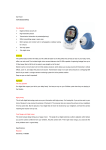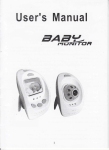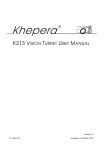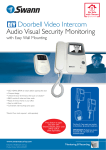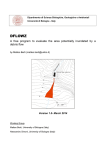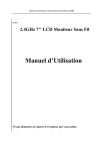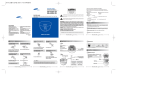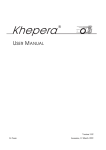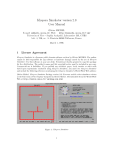Download Khepera® - K-Team FTP area
Transcript
Khepera ¨ K2D VIDEO TURRET USER MANUAL Version 1.1 K-Team S.A. Lausanne, 10 March 1999 Documentation author K-Team S.A. Ch. du Vuasset CP 111 1028 Préverenges Switzerland Trademark Acknowledgements Khepera: K-Team S.A. NOTICE: • The contents of this manual are subject to change without notice. • All efforts have been made to ensure the accuracy of the contents of this manual. However, should any errors be detected. In this case, please inform K-Team S.A.. • The above notwithstanding K-Team S.A. can assume no responsibility for any errors in this manual. TABLE OF CONTENT Introduction . . . . . . . . . . . . . . . . . . . . . . . . . . . . . . . . . . . . . . . . . 1 How to Use this Manual . . . . . . . . . . . . . . . . . . . . . . . . . . . 1 Safety Precautions . . . . . . . . . . . . . . . . . . . . . . . . . . . . . . . . . . . . 1 Unpacking and Inspection . . . . . . . . . . . . . . . . . . . . . . . . . . . . . . 1 The K2D video turret . . . . . . . . . . . . . . . . . . . . . . . . . . . . . . . . . 2 Overview of the turret . . . . . . . . . . . . . . . . . . . . . . . . . . . . 2 Serial/video connection module . . . . . . . . . . . . . . . . . . . . . 2 K2D cable unroller . . . . . . . . . . . . . . . . . . . . . . . . . . . . . . . 3 Video camera specifications . . . . . . . . . . . . . . . . . . . . . . . 4 Connections . . . . . . . . . . . . . . . . . . . . . . . . . . . . . . . . . . . . . . . . . 4 Assembling . . . . . . . . . . . . . . . . . . . . . . . . . . . . . . . . . . . . 4 Disassembling . . . . . . . . . . . . . . . . . . . . . . . . . . . . . . . . . . 5 Complete installation . . . . . . . . . . . . . . . . . . . . . . . . . . . . . 6 References . . . . . . . . . . . . . . . . . . . . . . . . . . . . . . . . . . . . . . . . . . 6 1 INTRODUCTION The hardware of Khepera is based on a modular concept. The K2D video turret is a module that can be plugged on the top of a Khepera robot making video acquisition possible. Due to the configuration and the geometric shape of this turret, no additional turrets can be plugged on the top of it. This kind of turret is called a “top turret”. The K2D video turret is a passive device without on-board processing. A video signal is delivered via a wired link to a fixed installation. At this level the video signal can be used by custom equipment not included in this package. 1.1 How to Use this Manual This manual is organised into four chapters. To learn how to make the best use of your K2D video turret you are urged to read all of chapters 1 through 4 (very short...!) Chapter 1 gives you a general introduction. Chapter 2 describes some important warnings. Chapter 3 explains the contents of the package. Chapter 4 gives an overview on the K2D video turret and the video/serial connection module. Chapter 5 explains how to connect the K2D video turret to the robot and to the host computer and video equipment. 2 SAFETY PRECAUTIONS Don't plug or unplug any connector or turret when the system is switched ON. All connections and turret insertions must be made when the robot and the interface are switched OFF. Otherwise damages can occur. Switch OFF the robot if you will not use it for more than a day. Disconnect the power supply removing it from the wall socket. 3 UNPACKING AND INSPECTION Please check that you have a complete package. You should find: • Documentation. • The K2D video turret. • The video/serial connection module. • The video/serial cable and the rotating contact device. • A power supply. 1 4 THE K2D VIDEO TURRET 4.1 Overview of the turret Top view Side view 1 2 Figure 1: Overview of the turret layout. Make an external inspection of the turret. Note the location of the following parts: 1. Video camera. 2. Serial/video connector. 4.2 Serial/video connection module The serial/video connection module has several functionalities: • It power supply both the Khepera robot and the camera. • It makes a standard RS232 serial link available. • It performs the signal processing to make a standard video signal available. 1 2 3 4 5 6 7 Figure 2: Layout of the serial/video connection module. 2 Please note the location of the following parts: 1. RS232 standard connector, for link to the host computer. 2. Green LED indicating the activity of the RS232 serial link for datas going from the robot to the host computer. 3. Red LED indicating the activity of the RS232 serial link for datas going from the host computer to the robot . 4. Minidin connection to the robot. 5. Power indicator. 6. Video output. 7. Power supply. IMPORTANT WARNING: to power this module please use only the power supply that has been delivered in the K2D package. This power supply is stronger than the standard Khepera one. If you use the standard Khepera power supply you can damage it! On the contrary you can use the K2D power supply for the normal Khepera interface and charger module. 4.3 K2D cable unroller The cable unroller gives to the robot more motion freedom. The general layout of this devide is the following: 1 2 3 4 Figure 3: K2D cable unroller layout. Please note the location of the following parts: 1. Connector to be plugged on the K2D video module (point 2 of figure 1). 2. Flexible cable. 3. Connector to the serial/video interface. 4. Mechanical attachements. 3 4.4 Video camera specifications The camera specifications depend from the model of K2D video module you have: Model K2D-B/W-PAL Image sensor 500(H) x 582(V) CCIR K2D-C-NTSC 510(H) x 492(V) PAL Scanning system Scanning frequency K2D-B/WNTSC Inter-line type 1/3” CCD solid state image sensor Effective picture element TV system K2D-C-PAL EIA NTSC 2:1 interlace Horizontal 15.625 KHz ± 1% Vertical 50 Hz ± 1% Synchronization system Horizontal 15.734 KHz ± 1% Vertical 60 Hz ± 1% Internal Horizontal resolution 380TV-lines or greater 330TV-lines or greater 380TV-lines or greater 330TV-lines or greater Min. illuminance of object 5.0 lux (at 50% signal level) 2.5 lux (at 50% signal level) 5.0 lux (at 50% signal level) 2.5 lux (at 50% signal level) > 45 dB ~ 48 dB > 45 dB ~ 48 dB 1/60 ~ 1/100’000 s 1/60 ~ 1/30’000 s S/N ratio γ=0.45 Gamma characteristics AGC ON IRIS control 1/50 ~ 1/100’000 s White balance 1/50 ~ 1/30’000 s ATW: 2600° K ~ 9000° K - Standard lens 2.5 mm 4 mm 2.5 mm 4 mm Optional lens 3.6 / 8 / 16 mm 5.6 / 8 / 16 mm 3.6 / 8 / 16 mm 5.6 / 8 / 16 mm 5 CONNECTIONS The assembling and disassembling of additional turrets is a delicate operation. Try to avoid as much as possible this manipulation and perform it carefully. Please follow the indication of this manual to avoid damages to your modules. The K-Team can assume no responsibility for any damage caused by wrong manipulations. 4 5.1 Assembling The assembling is the easier operation, but it is also necessary to perform it carefully: • First of all choose the parameters of the module on which you plug the new turret (the running mode that you will use on tha basic Khepera configuration, for instance) and set the jumpers if necessary. When the turrets is assembled, it is impossible to access to the modules that are inside the robot without disassembling it. • Assemble the turret with the basic configuration in two steps: In a first step place the module on the extension connector checking that all pins are on the correct place. In a second step apply a force to insert the additional turrets into the extension connector. • If you want to connect the robot to your workstation, use the serial connector of the turret placed on the top. • Operate as normal. 5.2 Disassembling This is the most difficult operation for people that are not suited to work with this kind of hardware. • First of all switch OFF the robot or disconnect the power supply. • Separate the turret to the rest of the robot. To do this operation without damages to the connections, the turret must be disconnected carefully and all connections have to be disconnected together. This can be made using a big plastic screwdriver and operating between the boards of the several modules. Be careful to do not force on delicate elements, like the pins of the circuits. Open some millimetres right, then left, then right.... and be very careful! Figure 4: How to disassemble an additional turret. 5 5.3 Complete installation The complete interconnection of all devices (including the host computer, a monitor and a Khepera robot not included in this package) has to be done following the indications of figure 5. In this figure the video equipment has been simplified to a monitor, but depends on the needs of the user. Video Monitor RS232 Host computer Figure 5: Interconnections for a full installation. IMPORTANT WARNING: For this installation please use only the power supply that has been delivered in the K2D video package. This power supply is stronger than the standard Khepera one. If you use the standard Khepera power supply you can damage it! On the contrary you can use the K2D power supply for the normal Khepera interface and charger module. 6 6 REFERENCES [Mondada93b] Mondada F., Franzi E. and Ienne P., "Mobile robot miniaturisation: a tool for investigation in control algorithms.", ISER3, Kyoto, Japan, 1993. [K-Team94] Khepera User Manual 3.0, K-Team manuals, Lausanne, 1994. 7 PERSONAL ANNOTATIONS 8











